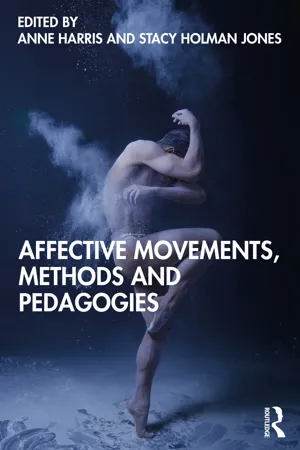Most performers know all too well the experience of standing backstage waiting to go on, and feeling the cold, clammy, where-can-I-run escape fantasy of ‘I can’t do this, get me out of here’. The flashing certainty that I might need to use the toilet, that my breath will come too short and shallow to project any words much less emotions, or the certainty that no one who may be in the audience out there will connect with what I have to offer. That physical contraction of knowing that the harder I fight against the nerves, the more insistent they become; what is sometimes called ‘stage fright’, when described in the language of emotions. But this apprehension, like all affective experience, is grounded in the body. In his ‘Confessions of an Apprehensive Performer’, Ron Pelias (1997) writes of his body:
First, it had the shakes—the hands fluttering, the kneeing knocking, the voice quivering. How can my body act without my intent? …Then, it was the pounding—the heart racing rhythm to the rapid speech and the breath disappearing in mid-phrase. Now, it goes deaf; it goes blind. (p. 32).
In proximity to an ‘audience’, these embodied experiences can be shared by those of us willing to ‘lean in’ to the precarity and thrill of performance. Leaning in to fear, to improvisation, to the pulsing preacceleration1 (Manning, 2009, p. 13) of the body doing its thing in relation to other bodies. Binaries fall away: no longer are ‘they’ out there while ‘I’ am inside the blinding light, no longer are they are relaxed while I am tense, no longer are they watching my internal struggle from the outside. What we think of ‘as performance’ is the field of experience and affect passing between and among us, together. The distance between bodies, smells, temperatures, words, movements of the performance, is coloured and set in motion in space. Space, that defining and core component of performance, can be measured in distance, but also in the changing affect between bodies-in-performance: forces vibrating, emerging ‘from surfaces, recombining with lines, folding, bridging, knotting’ (Manning, 2009, p. 13). Performance is a coming together that celebrates the ability of bodies to move and be moved through practice and in proximity (Harris & Holman Jones 2018). When we lean on one another, as Manning might put it, performance is an affective negotiation of bodies worlding.
Pelias stays with us, using the apprehensive and pulse-racing experience of performance to consider how ‘bodies place themselves in relationship to other bodies’ (2016, p. 9). He writes, ‘When bodies tilt toward each other, they may begin to move in the same rhythm, with the same pulse. They may sense themselves in an empathic encounter, each understanding and feeling with the other’ (2016, p. 9). Through the practice of attunement—the embodied work of tuning in to one another through the occasion of performance—‘presence turns space into place’ and ‘calls for a negotiation of bodies’ (2016, pp. 44, 9). We wonder about the non-binary possibilities of leaning in rather than staying or going, about how bodies are both soothed and stressed by leanings and leanings-in. How might a leaning be/come both an event and also an affective inclination, a moment of connection in which bodies come into contact?
To consider performance as affective inclination is to call attention to performance’s relational force, and to look to affect studies and posthumanism for a language of inclination-as-relation. For example, Rosi Braidotti (2019) asks us to reconsider notions of ‘a’ subject in/of performance as ‘an autonomous capacity’ defined not by ‘rationality, nor our cerebral faculties alone, but rather by the autonomy of affect as a virtual force that gets actualized through relational bonds’ (p. 38). Braidotti also urges a decoupling of affect from
individualized emotions, as meaningful expression of psychological states and lived experiences. Affect needs to be de-psychologized, and to be de-linked from individualism in order to match the complexity of our human and non-human relational universe. This relational process supports a thick and dynamic web of interconnections by removing the obstacles of individualism.
(Braidotti, 2019, p. 38)
Similarly, Manning’s writing on movement, in its changing force and direction and becoming elastic in relation to an other body, whether linked by touch or at a distance, turns our attention to performance as ‘relational shape-shifting’ (Manning, 2009, p. 13). Approaching performance as inclination allows us to consider performance as a more-than-human set of relations and the value of performance to creating sustainable ecologies.
If performance is a form of sociality in which ‘some performing bodies appear to be saturated with the terror of precarious life’ (Diamond et al., 2017, p. 2), affective leanings in performance are a ready lens through which the effects of sexism and misogyny, human exceptionalism, and cultures of terror can be not only seen, but felt and understood in both empathic and embodied ways (Harris & Holman Jones, 2019a, 2019b). In this chapter, we ask how, taken together, performance and affect studies gives posthuman ethics breath and flesh by expanding understandings of matter, discourse and enactment as they move in relational embodiment.2 This chapter also seeks to extend affect scholarship and its ability to reconceptualise the political promise of the collective and spatial relations through the lens of performance.
